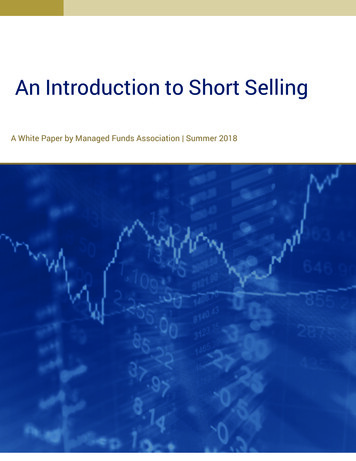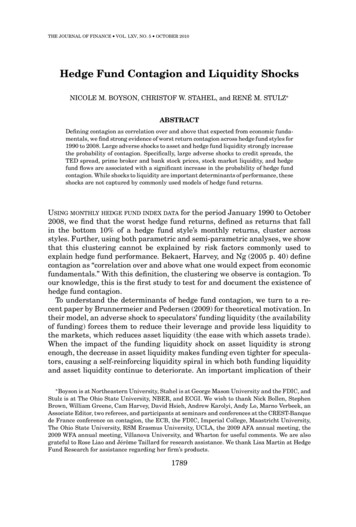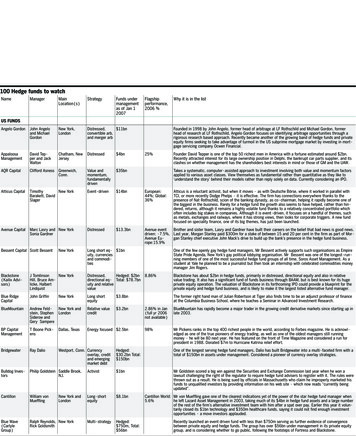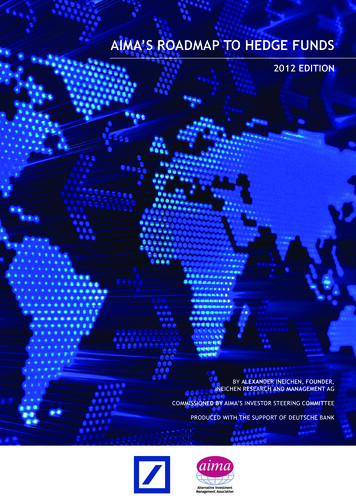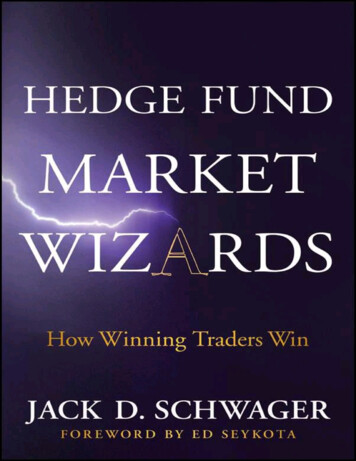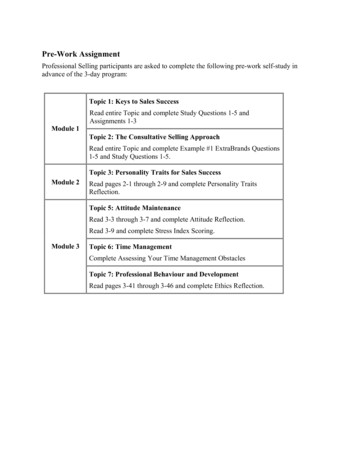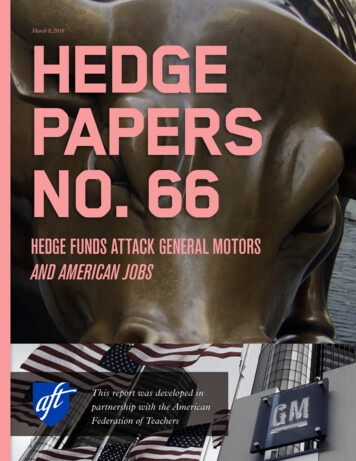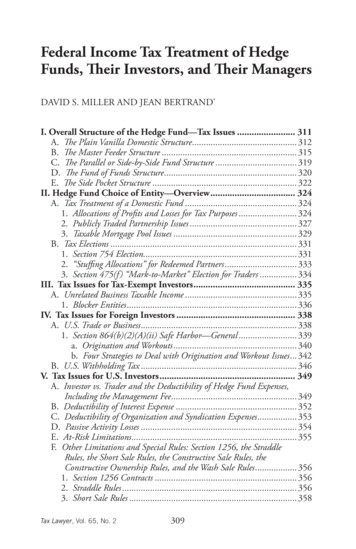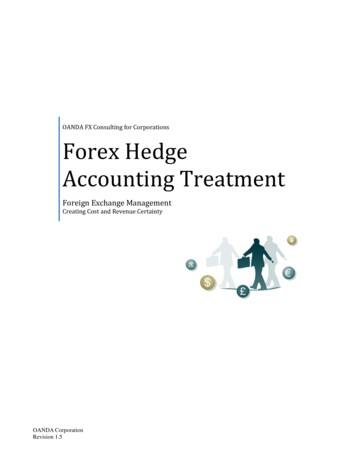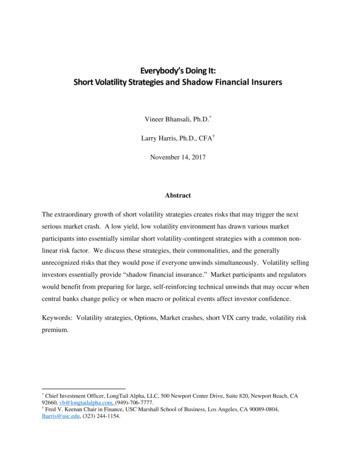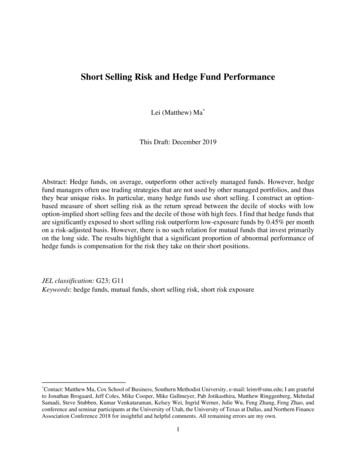
Transcription
Short Selling Risk and Hedge Fund PerformanceLei (Matthew) Ma*This Draft: December 2019Abstract: Hedge funds, on average, outperform other actively managed funds. However, hedgefund managers often use trading strategies that are not used by other managed portfolios, and thusthey bear unique risks. In particular, many hedge funds use short selling. I construct an optionbased measure of short selling risk as the return spread between the decile of stocks with lowoption-implied short selling fees and the decile of those with high fees. I find that hedge funds thatare significantly exposed to short selling risk outperform low-exposure funds by 0.45% per monthon a risk-adjusted basis. However, there is no such relation for mutual funds that invest primarilyon the long side. The results highlight that a significant proportion of abnormal performance ofhedge funds is compensation for the risk they take on their short positions.JEL classification: G23; G11Keywords: hedge funds, mutual funds, short selling risk, short risk exposure*Contact: Matthew Ma, Cox School of Business, Southern Methodist University, e-mail: leim@smu.edu; I am gratefulto Jonathan Brogaard, Jeff Coles, Mike Cooper, Mike Gallmeyer, Pab Jotikasthira, Matthew Ringgenberg, MehrdadSamadi, Steve Stubben, Kumar Venkataraman, Kelsey Wei, Ingrid Werner, Julie Wu, Feng Zhang, Feng Zhao, andconference and seminar participants at the University of Utah, the University of Texas at Dallas, and Northern FinanceAssociation Conference 2018 for insightful and helpful comments. All remaining errors are my own.1
There is no “alpha.” There is just beta you understand and beta you do notunderstand, and beta you are positioned to buy versus beta you are already exposedto and should sell.– John Cochrane, AFA 2011 Presidential Address1. IntroductionCompared to traditional actively managed portfolios, hedge funds deliver superior alphas(Liang 1999; Stulz 2007).1 While the superior performance of hedge funds can result from theirability to exploit flexible investment strategies and unconventional investment assets (Fung andHsieh 1997), studies have shown that at least part of their superior performance is attributable torisk premia associated with risk factors not captured by standard benchmark models.2 As a groupof sophisticated arbitrageurs, hedge funds often use short selling as an important investment toolto generate arbitraging profits. Thus, in this study, I investigate hedge funds’ exposure to shortselling risk. My primary finding is that hedge funds’ exposure to this risk significantly andpositively relates to their future returns, after controlling for exposures to other documented riskfactors. In contrast, for mutual funds that mainly hold long-equity positions, there is no suchrelation. In other words, part of the superior performance of hedge funds stems from a riskpremium resulting from their short selling strategies.Finance theories often assume that short selling is risk free and costless (e.g., Markowitz1952; Sharpe 1964; Ross 1976). However, a growing literature emphasizes that shorting a stock isrisky. The dynamic risks associated with short selling—the risk of future recalls and of changing1Liang (1999) documents that the efficient frontier of hedge funds surpassed that of mutual funds. In addition, asurvery by Stulz (2007) shows that hedge funds produce a 3% to 5% annualized alpha.2The literature has documented that hedge funds exhibit option-like returns. For example, when analyzing hedge fundreturns, Fung and Hsieh (1997, 2001), Mitchell and Pulvino (2001), and Agarwal and Naik (2004) propose risk factorsto account for the risks associated with hedge funds’ option-like dynamic trading strategies. In addition, recently, Baliet al. (2014) report that hedge fund returns relate significantly to loadings on macroeconomic risk factors becausehedge funds aggressively pursue opportunities arising from changing economic circumstances.1
equity loan fees—are significant risks that short sellers bear (e.g., D’Avolio 2002, Dreslter andDrestler 2018, and Engelberg et al. 2018).3 Shleifer and Vishny’s (1997) model predicts that, whenarbitrage is riskier, stocks exhibit greater mispricing and average returns to arbitrage are larger. Inline with the work of Shleifer and Vishny (1997), the model of D’Avolio (2002) predicts thatshorting overpriced stocks is risky. In particular, D’Avolio (2002) shows that stock loan feesincrease and share availability decreases as a function of the heterogeneity in beliefs of differentinvestors, and a large literature suggests that overpricing increases as a function of heterogeneityin beliefs (e.g., Miller 1977). Thus, stocks that are more overpriced are also riskier to short. Thatis, they are more likely to be recalled by lenders or to experience significant increases in lendingfees. Consequently, arbitrageurs bear a larger risk when shorting these stocks. Building onD’Avolio (2002), Drechsler and Drechsler (2018) show that arbitrageurs demand risk premium forbearing the risk associated with short selling. By shorting overpriced stocks, arbitrageurs deviatefrom holding the aggregate market portfolio and thus are more exposed to the short selling riskassociated with those stocks. As long as arbitrageurs are not risk neutral, they demand a riskpremium.Short selling risk could be important to the hedge fund industry for two reasons. First, bybetting against overpricing, fund managers often hold concentrated short positions and thus theirshort selling risk is unlikely to be diversified away.4 Second, Shleifer and Vishny (1997) predictthat arbitraging—in this case, short selling—is particularly risky for the portfolio managementindustry due to an agency problem. Specifically, because investors tend to withdraw capital fromhedge funds with poor performance (e.g., Sirri and Tufano 1998), if the overpriced stocks that3Under current regulations, equity lenders in the United States maintain the right to recall or cancel an equity loan atany time. When recalls occur, stocks lenders will take their shares back before the short sellers realize arbitrage profits.4For example, in 2012, hedge fund manager Bill Ackman made a 1 billion short bet against Herbalife, comprising alarge position in his fund’s portfolio.2
hedge funds bet against are recalled by lenders before their prices return to the fundamental value,the funds are at a greater risk of capital outflows resulting in losses on their short positions.Collectively, these theories suggest a positive cross-sectional relation between hedge funds’exposure to short selling risk and their future performance.To test this conjecture, I use option-implied loan fees — the expected (future) equitylending fees over the life of the option — to measure short selling risk. Engelberg et al. (2018)argue that a share recall can be considered as an extremely high equity loan fee. Therefore, thismeasure captures the D’Avolio’s (2002) theoretical construct of the dynamic risks perceived byshort sellers — the risk of future recalls and increases in future loan fees. In addition, the use ofoption-implied loan fees as a proxy allows me to perform my analyses over a long sample period,spanning from January 1996 through December 2015.I construct a market-based short selling risk factor on the basis of option-implied loan fees.Specifically, for each month starting from January 1996, I form equal-weighted decile portfoliosof stocks sorted by option-implied loan fees and then hold these portfolios for one calendar month.The short risk factor is the return spread between the decile of stocks with low option-impliedshorting fees (bottom decile) and the decile with high option-implied shorting fees (top decile).The short risk factor yields an average excess return of 1.54% per month and a Fama-French-fourfactor alpha of 1.59%, which cannot be attributed to conventional risk factors but rather be viewedas the return premium to short selling risk.I perform my empirical analyses using a sample of 5,388 U.S. equity-oriented hedge fundsover the period from January 1996 to December 2015.5 I start by measuring a hedge fund’s short5Because I focus on short selling risk pertaining to U.S. equity markets, my sample includes U.S. equity-orientedhedge funds in seven investment strategy categories: convertible arbitrage, event driven, equity market neutral, fundsof funds, long/short equity, dedicated short bias, and multi strategy.3
risk exposure as the covariance of its returns with the short risk factor. Specifically, for each hedgefund, I run a time-series regression each month of the hedge funds’ excess returns on the short riskfactor over the previous 36 months, controlling for the Fung and Hsieh (2004) seven factors, theCarhart (1997) momentum factor, and the Pastor and Stambaugh (2003) liquidity factor. Thecoefficient estimate on the short risk factor is the fund’s short risk exposure.I use both portfolio-level analyses and Fama and MacBeth (1973) cross-sectionalregressions to examine the effect of hedge funds’ short risk exposures in predicting theirperformance. First, when hedge funds are sorted into deciles by short risk exposures, the top decile,on average, outperforms the bottom decile by 0.44% (t-statistic 2.68) over the next month. Aftercontrolling for standard risk exposures, the spread in alpha is similar in magnitude, 0.45% (tstatistic 2.78) per month. Second, using a Fama and MacBeth (1973) regression framework, Icontinue to observe a positive relation between a hedge fund’s short risk exposure and its nextmonth’s performance after controlling for fund characteristics and investment style. These findingssuggest that the exposure to short selling risk is an important determinant of cross-sectional hedgefund returns.I perform a number of tests to corroborate and extend my primary findings. First, I examinethe relation between hedge funds’ short risk exposures and various fund characteristics. I find thatfunds that charge higher incentive fees and those that adopt high-water-mark provisions havelarger exposures to short selling risk, consistent with the notion that managerial incentives spurrisk taking. In addition, I find that funds with longer lock-up periods or redemption notice periodshave larger exposures to short selling risk, consistent with these restrictions protecting hedge fundsfrom forced liquidations and thus increasing their risk appetites.4
Second, I analyze the effect of short risk exposure among different investment styles ofhedge funds. I classify hedge funds into four groups according to their investment strategy(directional arbitrage, non-directional arbitrage, multi-strategy, and funds of funds) and find thatshort risk exposure relates positively and significantly to hedge fund returns only for directionalfunds. This finding is consistent with the notion that some directional funds are designed to profitfrom arbitrage opportunities through short selling.Third, I examine the return spread between the top and bottom short-risk-exposure decilesover different holding periods, ranging from 3 to 12 months. I find that the return spread betweenthe top and bottom short-risk-exposure deciles declines over time. In particular, the top decileoutperforms the bottom decile for up to six months after portfolio formation, and only 65% (41%)of the hedge funds in the top decile remain in the same decile after 6 (12) months. These resultsare consistent with the dynamic nature of hedge fund trading strategies leading to time-varyingshort risk exposures.Fourth, I explore whether the performance of hedge funds with high short risk exposurestems from fund managers’ abilities rather than just exposure to short selling risk. First, I use theextent to which hedge fund returns can be explained by systematic risk factors as a proxy for stockpicking ability, as Titman and Tiu (2011) show that funds managed by skilled managers havesmaller systematic risk-return associations. Second, because arbitrage profits vary with marketconditions, managers with market timing ability can adjust their short positions accordingly to gainlarger profits from short selling. I examine three market characteristics that skilled managers havebeen shown to be able to time: return, volatility, and liquidity (Chen and Liang 2007; Cao et al.2013). I find that hedge funds with larger short risk exposure, on average, are associated with lowersystematic risk-return associations, suggesting that managers of these funds are better stock pickers.5
However, I find no evidence that hedge funds with larger short risk exposure are better at markettiming. Next, I perform double sorts by first sorting hedge funds into quintiles based on systematicrisk-return associations and then sorting into quin tiles based on short risk exposure. For eachquintile of systematic risk-return associations, the spreads in returns and alphas between the topand bottom short risk exposure quintiles are both statistically and economically significant. Thesefindings suggest that hedge funds’ superior performance cannot be fully explained by managers’ability and that a considerable component of performance stems from compensation for shortselling risk.This paper makes several contributions. First, it contributes to the literature examininghedge fund returns and underlying risk factors (e.g., Fung and Hsieh 1997, 2001; Mitchell andPulvino 2001; Agarwal and Naik 2004; Sadka 2010; Bali et al. 2012, 2014; Jiang and Kelly 2014;Chen et al. 2016). By examining short selling risk, a previously unexplored risk, my study providesevidence that a significant proportion of hedge funds’ superior performance is compensation forshort selling risk. Evaluation of hedge fund performance is an important but challenging issue forfinance academics and practitioners because accurate inferences about hedge fund performancedepend on the appropriateness of the benchmark model used. The evidence here highlights theimportance of accounting for short selling risk when evaluating hedge funds.Second, my study contributes to the literature on limits to arbitrage. The theoretical modelof Shleifer and Vishny (1997) predicts that stocks that are riskier to arbitrage are more likely to bemispriced and offer higher returns to arbitrageurs. In the case of short selling, a recent empiricalstudy by Engelberg et al. (2018) shows that stocks with high short selling risk exhibit greateroverpricing and that arbitraging these stocks is rewarded with higher expected returns. Along thesame lines, Drechsler and Drechsler (2018) empirically show that abnormal returns to stocks with6
high lending fees reflect the premium that short sellers require for bearing the risk of their shortpositions. Extending these studies, my work provides direct evidence that short selling risk canpredict returns to arbitrageurs.Finally, my study advances the understanding of the performance of short sellers. As shownin the literature, short interest is highly informative about future returns (e.g., Senchack and Starks1993; Asquith et al. 2005; Cohen et al. 2007). Several studies find evidence suggesting that shortsellers earn higher returns due to either their information advantage or superior informationprocessing (e.g., Boehmer et al. 2008; Engelberg et al. 2012; Christophe et al. 2004; Choi et al.2017). My study complements these findings by documenting that part of short sellers’ superiorperformance represents a risk premium for short selling.The rest of the paper proceeds as follows. Section 2 develops the theoretical motivation.Section 3 discusses the sample, data, and variable measurement. Section 4 reports the empiricalfindings. Section 5 shows a series of robustness checks. Section 6 concludes.2. Theoretical development and hypothesesIf there is no free lunch in financial markets (Friedman 1975), then higher investmentreturns must come from bearing higher risk. Whereas arbitrage is viewed by some as a risk-freereturn in an inefficient market, the classic work of Shleifer and Vishny (1997) suggests thatarbitrageurs are rewarded for bearing risk. Lowenstein (2000) draws an analogy betweenarbitraging and “picking up nickels in front of bulldozers.” D’Avolio (2002) demonstrates that inaddition to the traditional risks faced by other traders, short sellers face significant uncertainties7
about future equity lending conditions—the risk of recalls or the risk of increasing stock lendingfees.6Consistent with predictions in models of limits to arbitrage (e.g., Shleifer and Vishny 1997),D’Avolio (2002) predicts that a largely overpriced stock is more likely to be recalled by lenders,creating a large risk to arbitrageurs. The low subsequent returns of this stock are compensationearned by arbitrageurs for the short selling risk they bear. Specifically, the more a stock isoverpriced, the more it is affected by noise traders and likely to further move away from thefundamental value (e.g., DeLong et al. 1990). Because stock price reflects the opinions of the mostoptimistic investors (Miller 1977), as the price moves further away from its fundamental value,the lender’s valuation of the borrowed stock is more likely to fall below the marginal investor’svaluation (or market price). Consequently, the lender will recall (or cancel) the loan to profit fromselling the temporarily overpriced shares or to re-lend them at a higher loan fee. In either case, therecalled arbitrageur must cover her short position by buying back the shares and returning them tothe lender or re-establishing the short position at a higher loan fee. As a result, the arbitrageur faceslarger potential losses when shorting a stock with greater overpricing. As the price of theoverpriced stock drops to the fundamental value in the future, the arbitrageur, in return, is rewardedwith a larger arbitrage profit.Building on D’Avolio (2002), Drechsler and Drechsler (2018) develop a multi-periodmodel that predicts that arbitrageurs demand risk premium for bearing the risk associated withshorting overpriced stocks. Overpriced stocks receive the common stock from shorting, e.g., thosestocks are more likely to experience an increase in future loan fees and to be recalled by lenders.By shorting overpriced stocks, arbitrageurs bear non-diversified shorting risk by deviating from6Under current regulations, equity lenders maintain the right to recall or cancel an equity loan at any time.8
holding the market portfolio. In their model, arbitrageurs (or short sellers) are the marginal investorof overpriced stocks. As long as they are not risk neutral, they demand a risk premium. Becausethis risk is on the short side, a larger premium means a more overpriced stock. In the same vein,Cho (2019) shows that more mispriced stocks attract more arbitrage and covary more withcommon shocks from the act of arbitrage by institutional arbitrageurs, generating “arbitragingdriven” betas.In line with these theoretical predictions, Engelberg et al. (2018) show empirically thatstocks with high volatility of equity lending fees, a proxy for the short selling risk, exhibit greateroverpricing and lower average subsequent returns. In addition, Drechsler and Drechsler (2018)construct a short risk factor based on the level of historical equity loan fees and find that shortselling risk accounts for a significant proportion of eight anomalies returns.Short selling risk should be relevant to hedge funds for at least two reasons. First, manyhedge fund managers use short selling extensively to bet against overvalued stocks. In doing so,they often run portfolios with concentrated short positions, and thus short selling risk is unlikelyto be diversified away.7 Second, Shleifer and Vishny (1997) predict that arbitraging is particularlyrisky for the portfolio management industry. Investors tend to withdraw capital from hedge fundswith poor performance (e.g., Sirri and Tufano 1998). Thus, if the overpriced shares that hedgefunds bet against are recalled by lenders before their prices return to the fundamental value, thefunds face a larger risk of outflows.7For instance, Ben-David et al. (2012) cite a Goldman Sachs report stating that hedge funds took 85% of all equityshort positions going through Goldman’s brokerage in March 2010.9
If hedge funds that are more exposed to short selling risk are rewarded with larger averagereturns, there should be a positive cross-sectional relation between hedge funds’ exposures to shortselling risk and their performance. My study is the first to address this possibility empirically.3. Data and variable measurement3.1. Hedge fund dataI obtain hedge fund data from the Lipper TASS database. Since my main measure of shortselling risk begins in 1996, when the OptionMetrics data become available, my sample period ofhedge funds is from January 1996 through December 2015. TASS classifies hedge funds into 11self-reported style categories: convertible arbitrage, dedicated short bias, emerging markets, eventdriven, equity market neutral, fixed income arbitrage, funds of funds, global macro, long/shortequity hedge, managed futures, and multi strategy. Since this study focuses on shorting-selling riskin U.S. equity markets, I only include U.S. equity-oriented hedge funds and drop global macro,emerging markets, fixed income arbitrage, and managed futures.Following prior research, I apply several screens to the TASS hedge fund data. First, toaddress the concern that hedge funds may backfill returns when newly added to the database, Iexclude the first 12 months of returns for each fund. Second, I only include funds that reportmonthly net-of-fee returns in U.S. dollars and allow for redemption at a monthly or higherfrequency. Third, I delete duplicate funds from the sample and exclude funds with assets undermanagement (AUM) of less than 5 million. Finally, I require each fund to have at least 24 returnobservations. My sample then contains 5,568 hedge funds over the period from January 1996 to10
December 2015.[Insert Table 1 about here]Panel A of Table 1 reports summary statistics of hedge fund excess returns. It shows thatthe average monthly excess fund return is 0.38% and the standard deviation is 3.45%. Panel A alsoreports the summary statistics of hedge fund excess returns by investment style. Each fund in thesample is characterized as one of the following investment styles: convertible arbitrage, dedicatedshort bias, event driven, equity market neutral, fund of funds, long/short equity and multi-strategy.The different styles exhibit sufficient cross-sectional variation in average monthly excess return.Panel B of Table 1 reports the summary statistics of fund characteristics, including fundsize, fund age, management fee, incentive fee, high water mark provision, minimum investmentamount, lockup period, notice period, payout period, and whether the fund uses leverage. Thesesummary statistics resemble those in the previous studies that use the TASS data on hedge funds.3.2. Option dataI obtain option data from OptionMetrics for the period from 1996 through 2015. FollowingBlocher and Ringgenberg (2016), I drop options with less than 7 days or greater than 180 days tomaturity, offer price greater than ask price, nonpositive implied volatility, bid-ask spreads greaterthan 25%, and the absolute value of log moneyness greater than 0.3. These filters help to excludeilliquid options. Option bid-ask spread is measured as the difference between the best offer andbest bid divided by the midpoint. Moneyness is computed as the closing stock price divided by thestrike price of the option. I obtain the risk-free rate from OptionMetrics and linearly interpolate itfor days to maturity where no rate is listed. As the underlying stocks of many options pay dividends,11
I need to consider the present value of the dividend. I only keep options with regular dividends(annually, semiannually, quarterly, and monthly).3.3. Measure of short selling riskFollowing Engelberg et al. (2018), I use option implied loan fee as the main measure ofshort selling risk. Option implied loan fee is the required shorting fee within the option maturity,to eliminate the put-call parity deviations. The option-based measure of short selling risk offers atleast two advantages. First, it captures forward-looking shorting costs and thus comports with thetheoretical predictions of D’Avolio (2002). Compared to the level of current equity loan fees, shortsellers are more concerned with the dynamic risks of short selling: the risk of increases in futureloan fees and the risk of recalls. Engelberg et al. (2018) consider this measure as a proxy for exante short selling risk. Engelberg et al. (2018) and Muravyev et al. (2018) find that option impliedloan fees forecast both future loan fee increases and future recalls. Second, compared to the Markitdata which is available only for a few years, use of option-implied loan fee as a proxy allows meto perform the analyses over a long sample period, from January 1996 through December 2015.Ofek et al. (2004) and Evans et al. (2009) show that, when short selling costs aresignificantly high, put-call parity diverges from predicted value. We can use option prices toestimate short selling costs associated with a synthetic short position of the underlying stock, whichcan be established by writing a call option and buying a put option with the same strike price andtime to maturity. 8 I estimate option implied loan fees by using the following put-call parityequation.8More recently, several studies have adopted a similar approach to measure short selling fees (e.g., Muravyev et al.2018; Weitzner 2017).12
Calli,t - Puti,t Si,t - K e-r(T-t) - 6j 1 Di j e-r(T-t)(1)where Call is the closing bid of call prices, Put is the closing ask of put prices, S is closing stockprice for stock i on date t, K is the strike price, Di,j represents all j dividends paid on stock i fromdate t until expiration.9The implied loan fee for a short position within the maturity is calculated in three steps.First, I solve for Model (1) to get the interest rate (r) that equalizes the put-call parity. Second, Icalculate the option implied fee as the difference between the market-forward risk-free interestrate at date t with the same maturity and the implied r that equalizes the put-call parity. Third,option implied loan fee is computed from each unique put-call-strike-expiration pair. For eachstock and month, I measure a firm’s option implied (annualized) loan fee as the standard deviationof implied (annualized) loan fee across all pairs.Similar to Drechsler and Drechsler (2018), I construct an investable short risk factor, whichis monthly excess returns of long short (stock) portfolios based on the measure of short sellingrisk—the option implied loan fees. Specifically, for each month, I form 10 equal-weightedportfolios of stocks sorted by option implied loan fees in the past month and then hold theseportfolios for one calendar month. The short risk factor is the return spread between the decile ofstocks with low option implied loan fees (bottom decile) and the decile of stocks with high optionimplied loan fees (top decile). By construction, the return spread captures the risk premium thatarbitrageurs demand for bearing short selling risk (in that the portfolio return of high shorting feestocks, which is significantly lower than that of low fee stocks).I don’t incorporate the early exercise premium for American options. The possible bias created by the early exerciseof American options is likely mitigated by using the options that are closer to the money and with lower regulardividends. My results are robust to use only European options to estimate the short selling risk.913
Engelberg et al. (2018) use the volatility of daily shorting fees to measure the uncertaintyof future loan fees. Thus, I also construct an alternative measure of short risk based on the volatilityof option implied loan fees. For each stock and month, I measure a stock’s volatility of optionimplied (annualized) loan fee as the standard deviation of implied (annualized) loan fee across allpairs. The short selling risk factor is the return spread on a long short portfolio that is long thedecile of stocks with long volatility of loan fees and short the decile of stocks with high loan fees.The results based on the volatility of option implied loan fee are reported in Table 13.[Insert Table 2 about here]Panel A of Table 2 shows that, on average, stocks with high option-implied loan fees earnrelatively lower subsequent returns than those with low fees. In particular, the low-fee decile(decile 1) earns a monthly excess return of 1.03% and a monthly Fama-French four factor alphaof 0.31%, and the high-fee decile (decile 10) yields a monthly excess return of -0.51% and amonthly Fama-French four factor alpha of -1.23%. Consequently, the average return and FamaFrench four factor alpha of the short risk factor, as shown in Panel B, is 1.54% and 1.59% permonth, respectively.[Insert Figure 1 about here]Figure 1 depicts the time-series of monthly returns of the short risk factor. There issubstantive variation in the risk factor return over time, ranging from a low value of about -0.16%to a high value of around 5.36%. Such time-series variation is valuable for testing the potentialimpact of short selling risk in determining hedge fund returns.3.4. Mean-Variance Spanning TestsOne natural question to ask is whether the short risk factor captures the risk premium of14
existing well-known factors. In other words, whether a portfolio of the commonly used factors canreplicate the performance of the short risk factor?In this section, I explore whether the short risk factor lies outside the mean-variance frontierof the common risk factors, which is sufficient to show that the short risk factor cannot bereplicated by a portfolio of these factors. Huberman and Kandel (1987)
Short Selling Risk and Hedge Fund Performance Lei (Matthew) Ma* This Draft: December 2019 Abstract: Hedge funds, on average, outperform other actively managed funds. However, hedge fund managers often use trading strategies that are not used by other managed portfolios, and thus they bear unique risks. In pa
